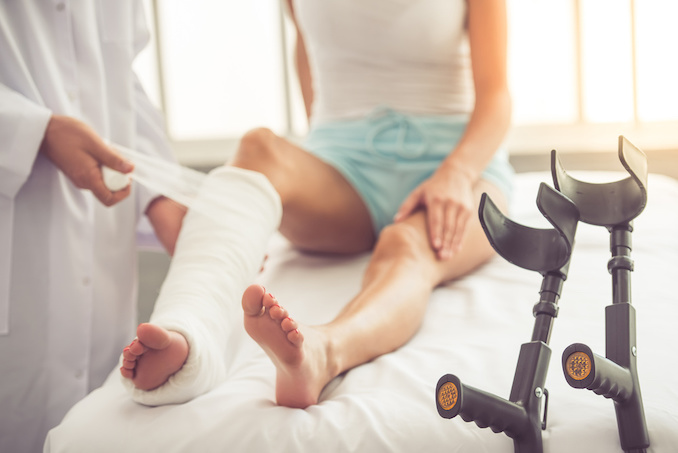Many people get their bones broken at least once in their lifetime due to accidents. Fractures are painful and can hinder your daily activities. However, you shouldn’t worry if you experience this kind of injury because they aren’t impossible to treat. In fact, fractures are one of the easiest to heal if done correctly.

If you break any of your bones, you must have it attended by a professional healthcare provider immediately. Delaying treatment or performing self-treatment without proper guidance can leave you with more problems than good results. Every injury has a specific remedy depending on the severity, which also applies to broken bones. So, do not self-diagnose to avoid unnecessary complications.
To prepare yourself in case an accident happens, read this guide to know the possible options to treat fractures.
1. Immobilization
One of the first methods to handle a broken bone is immobilization. This option is for mild fractures and bones that haven’t slipped out of their joints. Immobilizing the injury prevents movement, which can worsen the fracture. Splints and casts are the primary tools for immobilizing a broken limb.
If possible, it is best to keep a shell splint in your emergency medical kit to use when necessary. It’s portable and lowkey and can fit anywhere from your purse to the first-aid box at home. Otherwise, you can use a makeshift splint to protect your injury when you get into an accident while waiting for professional help to arrive. Whichever you use to keep your fracture in one place, it has to be stable enough to withstand some pressure. It mustn’t be too flexible or soft that minimal movement could break it.
Once a legitimate cast or splint replaces it, your injury could take around six to eight weeks to heal fully. Until then, you shouldn’t move the affected limb around too much. You’ll also require frequent checkups for minor adjustments to ensure that the bone is healing in the right place.
2. Closed Reduction
Some fractures are so severe that they’ll need a closed reduction treatment to set the broken parts correctly. It’s a non-surgical procedure where the medical professional moves your limbs to realign the bones. A closed reduction provides many benefits to patients, such as the removal of tension and reduced swelling on the affected part. Other advantages include the following:
- Lessened risk of infection
- Improved limb movement
- Decreased pain
- Faster healing
This procedure works best when done immediately after the fracture happens. This method is as painful as it sounds. Fortunately, most patients who receive this treatment often take sedatives, local anesthesia, or general anesthesia to numb the pain or to make them sleep.
After a closed reduction treatment, doctors will put a splint or cast made from fibreglass or plaster of Paris. You will also need to visit your healthcare provider regularly to check on your injury’s condition as it heals.
3. Internal And External Fixation
If you get into an accident that fractures your bones badly, you may need surgery to treat it. The method depends on the injury site and its severity. The surgeon might also have to put implants in your body to stabilize the bone to help it heal correctly. Some patients have them removed after the fracture heals, while others must keep them on for life, even if they do sports or go back to the gym after the injury.
Internal fixation is one kind of surgical option for patients with broken bones. Surgeons often insert rods, screws, pins, plates, or wires to settle the bone in a fixed position until it heals. As mentioned, the inserts stay there either temporarily or permanently.
Another surgical method for fractures is external fixation. This treatment also incorporates inserts to stabilize the bone. However, it differs from internal fixation by using an outer brace or bracket around the injured area, which is usually connected to the inserts. In certain cases, your surgeon may also perform an external fixation procedure before your internal fixation surgery.

4. Bone Grafting
Some broken bones can be terribly displaced from their original positions and may need a far more complex treatment. Your healthcare provider might suggest bone grafting to treat this particular injury. If you know what plant grafting is, the procedure is similar.
Surgeons who use this treatment on fractures will take bone tissue from your other healthy, uninjured bones and transplant them to the affected areas. Some may even extract bone tissues from cadavers donated to the hospital. Other times, they’ll use an artificial material if actual bone tissues are unavailable.
The new tissues will produce cells to seal themselves to your broken bone. By having these additions to your fracture, your bone will have an easier time healing itself. Afterwards, you may wear a sling, brace, or cast to immobilize the area.
5. Arthroplasty
Many fractures happen on the upper and lower limbs, but they can also occur on joints like your shoulders, elbows, and knees. If your injury is from one of these areas, you might need arthroplasty or joint replacement.
Your affected joint will have to be removed and replaced with an artificial one by your surgeon. The materials used as a replacement may be made of ceramic, metal, or plastic intended for surgical purposes. It should work and move the same way as your original joint. However, your doctor may recommend you undergo physical therapy to manage pain and improve your mobility.
Putting The Pieces Together
There are several treatment options for different levels of fractures and where they are. Your healthcare provider should know what to do if you have a broken bone. After getting treatment, you must follow your doctor’s instructions to let your injury heal quickly and efficiently. Only then will you get back to your normal movement.

